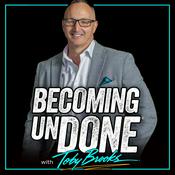Available Episodes
5 of 187
- E182 - Mark Patey - Transition from Flying Cowboy to Safety AdvocateIn this episode of Behind the Prop, hosts Bobby Doss and Wally Mulhern welcome Mark Patey — entrepreneur, aviator, and co-founder of Best Tugs and Best Aviation Products — for a powerful conversation on aviation innovation, safety, and personal growth. With over 12,000 flight hours and nearly three decades of flying experience, Mark shares how his passion for engineering and aviation led to building products that offer twice the value for only 10–20% more cost, creating a winning formula for pilots who prioritize both performance and safety. His companies now have 47 new aviation products under development, each designed to make flying more efficient, safer, and more enjoyable.Beyond business, Mark opens up about his transformation from the thrill-seeking days of the “Flying Cowboys” to becoming a safety advocate focused on humility and honesty. He reflects on how earlier flying videos showcasing aggressive backcountry flying unintentionally encouraged risk-taking, and how experience — along with age and perspective — taught him the true meaning of responsible flying. Mark emphasizes that proficiency and preparation make the difference between danger and mastery, comparing backcountry flying to instrument flying: both can be safe or deadly, depending on skill and mindset.The discussion also explores the growing issue of negativity in online aviation communities, where misinformation and quick judgments often drown out real learning opportunities. Mark and the hosts discuss the need for empathy, understanding, and constructive dialogue among pilots. In response to the fear and stigma surrounding mistakes, Mark introduces his vision for a “Pilot Confessional” podcast, where aviators can anonymously share near-miss experiences and lessons learned — helping others avoid similar situations without fear of backlash or violation.In a heartfelt conclusion, Mark reveals how a near-death medical experience reshaped his outlook on life and aviation. No longer chasing records or recognition, he now prioritizes peace, longevity, and family. His message to the aviation community is clear: be honest about your skills, stay humble, and fly for the love of life — not the thrill of risk.--------42:17
- E181 - Beyond the Check Ride - Building Real World Pilot JudgmentIn this episode of Behind the Prop, hosts Wally Mulhern and Bobby Doss dive into one of the most important and often overlooked stages of a pilot’s development — the period right after earning a Private Pilot Certificate, when decision-making truly begins. While training provides structure and supervision, real pilot-in-command judgment is built through solo experience, reflection, and continuous learning.Wally explains that many new pilots complete training with strong technical skills but little real-world decision-making experience. He compares flying to golf — once the fundamentals are learned, consistent, thoughtful application separates good pilots from great ones. Without the safety net of an instructor, new private pilots must learn to evaluate fuel, weather, and personal minimums on their own. Both hosts emphasize that certification is not the finish line but the starting point of lifelong learning.The conversation covers key tools like the PAVE acronym (Pilot, Aircraft, enVironment, External pressures), which provides a structured way to assess preflight risk. Wally and Bobby also stress the importance of mental rehearsals and “what if” scenario planning to strengthen decision-making during unexpected events. Through real stories — from leaving chocks in place to handling equipment failures — they illustrate how small mistakes can lead to valuable lessons when managed properly.Technology plays a major role in modern flying, but the hosts caution against overreliance on apps and automation. Errors in systems like ForeFlight can mislead pilots who fail to verify data manually. Proficiency, not just currency, is the foundation of safety. Pilots are urged to set personal minimums, fly regularly with instructors, and stay humble about their skill level, especially after certification.The episode closes with a powerful reminder: good judgment is learned through experience, reflection, and discipline. Wally and Bobby encourage pilots to embrace real-world flying, learn from others’ incidents, and view every flight as an opportunity to refine decision-making. Their shared vision promotes a culture of continuous learning and safety, helping pilots evolve from newly certified to truly competent and confident aviators.--------40:31
- E180 - Flight Planning the Night Before: Your Key to a Smoother CockpitIn this episode, Wally Mulhern and Bobby Doss take listeners deep into the mindset and methods behind effective flight planning. They break down how professional pilots think, plan, and prepare—long before the engine ever starts.Wally explains why smart flight planning begins weeks in advance, sometimes as early as 20 days before departure, especially for longer trips. He shares how to select fuel stops just beyond the halfway point—around 280 to 320 miles—to maintain both efficiency and mental endurance. Past experiences taught him that chasing cheaper fuel can backfire through delays and limited services, making reliability and safety worth the extra cost.Weather plays a defining role in every flight, and Wally emphasizes checking forecasts repeatedly—three weeks, two weeks, ten days, and again the night before. He outlines how to analyze broad surface charts, TAFs, and METARs to anticipate conditions, adjust routes, and account for winds that can change fuel burn by up to 20% in a Cessna 172. He also discusses planning around TFRs and keeping alternate airports ready, even when not required.Bobby builds on that foundation with his focus on cockpit organization and readiness. His night-before checklist includes verifying oil levels, charging devices, updating ForeFlight, and packing flight materials. These habits reduce stress, save time, and make each preflight smoother. Wally echoes this with his own structured airline routine—packing the night before, updating iPads, and keeping notes on the yoke for future pilots. Both stress that good organization directly impacts performance and safety, especially during check rides.Together, they underline a shared philosophy: prepare early, plan thoroughly, and stay flexible. Weather forecasts are only predictions, sound judgment and real-time decision-making matter most. Their combined airline and general aviation experience shows that professional-grade preparation leads to safer, more confident flying.Whether you’re a new student pilot or seasoned aviator, this episode delivers actionable insights on fuel management, weather interpretation, and cockpit discipline—helping you fly smarter, safer, and more like a pro.--------41:16
- E179 - A Day in the Life of a Flight School OwnerIn this episode, host Bobby Doss and co-host Wally Mulhearn dive deep into what it truly takes to run a modern flight school day to day. Bobby offers a transparent look at the enormous scope of responsibilities behind United Flight Systems—from facilities and fleet management to staff culture and student success—illustrating that being a flight-school owner is far more than “counting gold bars.”The conversation begins with Bobby describing the constant balancing act of maintenance, compliance, and customer experience. He emphasizes the unseen details that shape safety and efficiency: reliable internet, plumbing, lighting, hangar upkeep, and even thoughtful touches like pull-through aircraft parking, which saves students time and money. The two outline the structure of the show in aviation terms—takeoff, cruise, and landing—mirroring the rhythm of a typical workday.During the “takeoff” segment, Bobby explains his early-morning ritual: checking weather with the Windy app, reviewing schedules, and coordinating with his leadership team to prepare for any disruptions. In “cruise,” he details the constant hum of operations—maintenance calls, last-minute squawks, and people management for nearly 50 employees. He describes leadership as both rewarding and exhausting: motivating staff, resolving conflicts, and maintaining the culture of “UFS to the 5th Power”—Safety, Students, Staff, School, and Self.As the day “lands,” Bobby focuses on reflection and preparation. End-of-day check-ins, milestone tracking, and student-record verification ensure accountability and celebration of progress. He underscores his commitment to safety, continuous improvement, and recognizing both instructor and student achievements. Despite the administrative load, Bobby remains deeply engaged—flying when possible, mentoring, and cherishing the impact his school makes on aviation careers.The episode closes on gratitude and perspective: Bobby and Wally celebrate 500,000 downloads of Behind the Prop, expressing pride that their conversations help pilots become safer and more informed. It’s a heartfelt, behind-the-scenes portrait of dedication, discipline, and passion that defines life as a flight-school owner and aviation advocate.--------51:41
- E178 - Barry Knuttila, King Schools President & CEOWhat happens when a tech executive with a passion for flying gets the chance to combine both worlds? In this episode of Behind the Prop, hosts Bobby Doss and Wally Mulhearn welcome Barry Knuttila, President and CEO of King Schools, to explore that exact story.Barry recounts his early flying background, how a corporate collapse unexpectedly redirected his career, and the fateful moment he reached out to John and Martha King. That outreach led to a role as CTO during King Schools’ transition to the internet era, eventually growing into leadership of the company itself. Along the way, Barry earned advanced ratings, flew Falcons with John and Martha, and became a familiar on-camera instructor.The discussion highlights King Schools’ unique ethos—authenticity, humility, and an unwavering focus on student success. Barry explains how listening to customer feedback and treating students like friends has guided the company from the days of shipping VHS tapes to today’s mobile-friendly apps, flashcards, and integrated flight school tools.Listeners will hear about how the flight training industry has shifted from primarily self-paced, individual learning to ab initio, career-focused programs. Barry shares how King Schools has responded by expanding its B2B offerings for universities and flight schools while continuing to serve individual learners. The conversation also covers innovations in course design, the importance of breaking training into smaller, more consumable segments, and King Schools’ efforts to reduce checkride anxiety through immersive preparation courses.From personal reflections on flying helicopters and biplanes for fun to insights on the future of aviation training, Barry’s perspective underscores both the timeless values and forward-looking vision that continue to shape King Schools. Whether you’re a student pilot, CFI, or aviation enthusiast, this episode offers inspiration and practical wisdom for every stage of the journey.--------43:06
More Education podcasts
Trending Education podcasts
About Behind the Prop
Behind the Prop is the Podcast for anyone involved in aviation from general aviation to professional pilots. Our hosts Bobby Doss is the owner of a flight school in Houston, Texas, and Wally Mulhearn is a pilot for a major airline and is also a designated pilot examiner (DPE) based in Houston, Texas. Weekly they tell stories, share lessons and tips from behind the prop. Together they have over 24,400 hours of flight time (Wally has over 24,000 of those) and collectively they provide very unique perspectives on general aviation, airplanes, and all things aviation.
Podcast websiteListen to Behind the Prop, The Daily Stoic and many other podcasts from around the world with the radio.net app

Get the free radio.net app
- Stations and podcasts to bookmark
- Stream via Wi-Fi or Bluetooth
- Supports Carplay & Android Auto
- Many other app features
Get the free radio.net app
- Stations and podcasts to bookmark
- Stream via Wi-Fi or Bluetooth
- Supports Carplay & Android Auto
- Many other app features


Behind the Prop
Scan code,
download the app,
start listening.
download the app,
start listening.







































